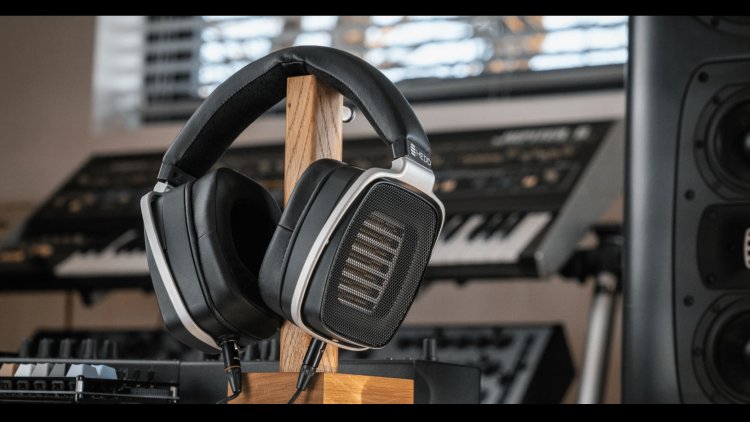HEDD HEDDphone: superior sound thanks to AMT

HEDD, a Berlin-based studio and hi-fi company, is bringing a pair of very unusual headphones to the studio and hi-fi stage: Klaus Heinz, a high-end veteran, is in charge of HEDD. Arcus and ADAM Audio owe their existence to the sound pioneer. In Germany, he is considered as the foremost authority on the Air Motion Transformer technique, which he has used in studio monitors and hi-fi loudspeakers for years as a midrange or tweeter.
HiFi enthusiasts are aware of the theoretical benefits of this idea, which dates back to Dr. Oskar Heil. The German scientist studied chemistry, mathematics, physics, and music, among other subjects. A lucky break and a winning combination that should lead the late loudspeaker pioneer to exceedingly promising research results: Heil was fascinated by the practical aspects of human hearing, and in the 1960s, he created the "Heil-AMT" tweeter.
After the patent protection expired, a few manufacturers, including ELAC (with Klaus Heinz's support), Adam Audio, and HEDD, followed this hitherto unknown theory of the "Air Motion Transformer": firm owner Klaus Heinz was impressed by the principle early on and exchanged ideas with Oskar Heil. In an interview, Klaus Heinz recalled, "I met Oskar Heil in 1985." "This concept and the auditory consequences of his "ESS" speakers captivated me. This tweeter sounded so precise and bright to me that it was as if someone had pulled the curtain back on all my favorite songs."
Klaus Heinz met Heil in his house in San Mateo, Silicon Valley, outside San Francisco. "I learned about his life and we talked about electrons (his favorite 'animals') and loudspeakers, of course." Heil's open thinking and persistent search for new ways to make good sound impressed me."
HEDD HEDDphone with AMT power
Heinz is now incorporating the technology into his first headphones, the HEDDphone. This means that the beginner is virtually alone in the realm of hi-fi. After all, the modest (and little-known) Swiss manufacturer Precide, led by inventor Martin Dürrenmatt, has already manufactured the famous "Jecklin Float" electrostatic gadget, and its "Ergo AMT" follows the same idea.
The AMT's role is as straightforward as it is efficient: Unlike typical dynamic, magnetostatic, or electrostatic models, the membrane is folded in delicate folds, much like an accordion. It has conductor tracks that shift the membrane as current runs through it. In the literal sense, this is an incredibly effective principle.
"The membrane pushes air out and sucks it back in, allowing the air to flow three to four times faster," Klaus Heinz explains. The air shoots out of and back into the cone folds at breakneck speed - a modest cone movement can generate a surprisingly significant amount of sound pressure. A permanent magnetic field serves as a teammate for these acoustic processes.
The key benefits are improved pulse behavior and increased efficiency. "Because the membrane surfaces of traditional and planar headphones are only as large as the headphone cup, they function as 1:1 pistons for air compression." The folded AMT, on the other hand, has almost three times the active cone area.
That means, on the one hand, the foil has to move less at a certain sound pressure level, and on the other hand, stronger dynamics are possible if the amplifier has the necessary power," explains Klaus Heinz. So it's no surprise that the AMT is currently on a tear through the higher-quality loudspeakers.
But what works well with a loudspeaker tweeter had to be rethought for the size and tasks of a headphone - with "VVT" technology, the "Variable Velocity Transformer," which spans the entire audio spectrum, in the case of the HEDDphone from 10 to 40,000 Hertz. "During the creation of the HEDDphone, it became necessary to rethink one of the major elements of the AMT," says Klaus Heinz.
The folds in the driver had to be developed in varied dimensions - both in width and depth, which was a step forward. And it was patented by the audiophile pioneer. "Air Motion" is believed to be the official name for Berlin's best air…
The HEDDphone is packaged in a luxuriously dimensioned, well-made cardboard box, in which the handset and cord lie individually and are cushioned. The pluggable 4-pin micro XLR cables are housed in a separate box and terminate after 2.2 meters at a 6.3-millimeter jack.
It's simple to connect. However, the eye must first search and examine intently to determine which cable makes the correct touch on the right or left. You are aware of this. One of many headphones' mysteries is almost completely concealing "left" or "right" marks.
The craftsmanship is excellent thanks to manual labor; there is nothing to complain about. In accordance with the general slogan "stable acoustics, durability, superior workability, and appealing look," the construction is distinguished by sewed synthetic leather and high-quality metal. The production takes place in Berlin at Salzufer 13/14, which is an ideal location.
Despite its astounding weight of 718 grams, the HEDDphone immediately felt like a good friend. The soft ear cups fit around the ears with mild pressure, and the headband, thanks to the flexible storage, also goes on a gentle cycle. Even if it is not regarded as a permanent attachment, the seat appears to be rather natural.
That is to say, despite the mass, the wearing comfort is excellent, as long as you take breaks from time to time. The same as a classical concert. The weight, according to Klaus Heinz, is due to "the required magnets and pole plates - we're attempting to do that better in the future generation, but it's a fundamental challenge."
However, the HEDDphone is a stationary listener not just in terms of weight and cumbersome look, but also electrically. Contrary to the AMT principle's high-efficiency promises, these headphones are quite quiet and require approved headphone amplifiers.
The HEDDphone required an amazing 0.831 V at 41 to obtain the identification voltage of 94 dBspl / 500 Hz in the measuring laboratory (according to IEC 60268-5). This translates to 17 mW and is sufficient to overwhelm all smartphones and tablets. He wouldn't mind playing on the small all-rounders. However, their power is insufficient.
It's large and hefty, hangs from the cord, and requires an approved headphone amplifier. This does not appear to be a current pair of headphones. Despite this, this quirky over-ear is quite modern: it sounds extraordinarily nice and is an acoustic feat for all those who respect precise dynamics, resolution, richness of detail, and airiness that is not surpassed by substantially more expensive models.
In terms of pricing, Klaus Heinz appears to have paid heed to the studio's "manageable" margins. A classic hi-fi listener with these qualities would have been much more expensive…





























